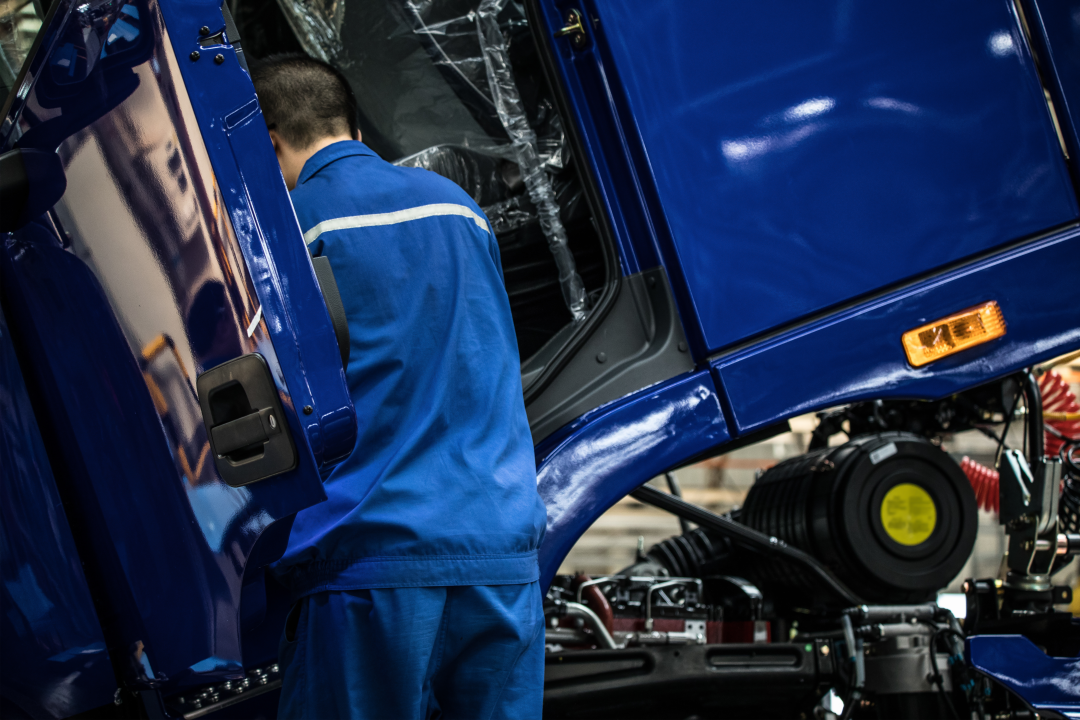
Susie Jones
Trucker mit Behinderungen - welche Unterstützung gibt es?
Erstellt: 12.08.2024
•
Aktualisiert: 12.08.2024
Im Vereinigten Königreich gaben [23 %] (https://commonslibrary.parliament.uk/research-briefings/cbp-7540/#:~:text=There%20were%209.58%20million%20people,of%20the%20working%2Dage%20population.) der Bevölkerung im erwerbsfähigen Alter an, behindert zu sein - was viele nicht wissen, ist, dass ein großer Teil davon Lkw-Fahrer sind, die endlos durch Europa fahren, um Ihre Waren auszuliefern. Obwohl sie mit vielen Herausforderungen konfrontiert sind, unterstreicht ihre Präsenz in der Lkw-Gemeinschaft die Bedeutung von Inklusion und Vielfalt in der Branche.
Kann ich einen Lkw fahren, wenn ich eine Behinderung habe?
Wenn Sie eine körperliche oder kognitive Behinderung haben, können Sie einen Lastkraftwagen fahren. Allerdings müssen Sie eine ärztliche Untersuchung bestehen, um festzustellen, ob Sie fit genug sind. Eine ärztliche Untersuchung besteht aus folgenden Punkten:
Ein Gespräch mit einem Arzt über Ihre Gesundheit: Autofahrer müssen ehrlich und offen sein.
Eine körperliche Untersuchung, bei der Ihr Arzt Sie untersucht:
Blutdruck
Das Herz
Vision
Test auf Diabetes
Neurologische Erkrankungen
Schlafstörungen.
Nach Abschluss des Verfahrens entscheidet die DVLA, ob Sie fahren dürfen.
Anpassungen am Lkw
Für Fahrer mit körperlichen Behinderungen sind die folgenden Anpassungen möglich:
Handschalter als Ersatz für Pedale
Lenkungshilfen
Beschleuniger mit dem linken Fuß
Umbau der Kupplung
Geschirre
Spezialisierte Sitzgelegenheiten
Ausrüstung zum Verstauen von Rollstühlen.
Im Jahr 2021 hat der Lkw-Hersteller MAN vier [Lkw für behinderte Fahrer] umgerüstet (https://trans.info/check-out-the-lorries-man-altered-to-accommodate-disabled-drivers-228342). Die Anpassungen umfassten die Ausstattung der Lkw mit einer Hebebühne, die Rollstuhlfahrern den Zugang zur Kabine erleichtert, wobei alle Bedienelemente am oder um das Lenkrad angebracht sind.
Obwohl die Technologie und die Anpassungen in der Branche voranschreiten, stehen viele behinderte Fahrer immer noch vor Herausforderungen bei der Arbeit.

Welche Hindernisse gibt es für behinderte Lkw-Fahrer?
Für behinderte Fahrer kann es schwierig sein, in der Branche Fuß zu fassen, selbst wenn sie die erforderlichen Qualifikationen besitzen und ihre ärztliche Untersuchung bestanden haben. Viele Unternehmen zögern, ein angepasstes Fahrzeug zur Verfügung zu stellen, da dies eine kostspielige Investition sein kann.
Für Fahrer, die bereit sind, für die notwendigen Anpassungen zu zahlen, ist es laut Andy, CEO der Wohltätigkeitsorganisation [Globe Truckers UK] (https://www.globetruckersuk.org/), immer noch schwierig, eine Beschäftigung zu finden.
"Einige Transportunternehmen zögern, behinderte Menschen einzustellen, weil sie oft Angst vor den Hindernissen haben, mit denen die Fahrer außerhalb der Kabine konfrontiert sind, z. B. Treppen und Heben.
David Chambers, ein behinderter Lkw-Fahrer, hat sich gegen die Prüfungen ausgesprochen, denen er täglich ausgesetzt ist, und angemessene Anpassungen des Gleichstellungsgesetzes gefordert - insbesondere nachdem die Regierung gefordert hatte, dass mehr Menschen, die Behindertenleistungen beziehen, zur Arbeit zurückkehren.
David und viele andere haben es auf großen Betriebshöfen schwer, wo der Betriebshof nach dem [Gleichstellungsgesetz] (https://www.legislation.gov.uk/ukpga/2010/15/contents) nicht verpflichtet ist, angemessene Anpassungen für Fahrer mit Behinderungen vorzunehmen. Aus Sicherheitsgründen müssen sie während des Entladens abseits ihrer Lastwagen warten, was bedeutet, dass sie lange Strecken laufen und Treppen steigen müssen.
Welche Unterstützung gibt es für behinderte Lkw-Fahrer?
Die Suche nach Unterstützung kann für Menschen mit lebensverändernden Verletzungen oder Krankheiten mühsam sein. Die britische Wohltätigkeitsorganisation Globe Truckers wurde von Fahrern gegründet, um Fahrern zu helfen - sie bietet Unterstützung für verletzte, kranke oder behinderte Menschen.
"Viele behinderte oder verletzte Autofahrer wissen nicht, an wen sie sich wenden sollen, da es nur sehr wenige Informationen für sie gibt. Hier kommen wir ins Spiel und bieten unsere Unterstützung und Beratung an - sei es, dass wir sie an die richtigen Leute verweisen oder finanzielle Mittel für Ausrüstung bereitstellen.
"Manche Fahrer brauchen einfach jemanden, mit dem sie reden können, und wir sind hier, um ihnen diese Unterstützung auf jede erdenkliche Weise zu bieten. In Zukunft würden wir gerne Anpassungen von Lastwagen für Fahrer finanzieren. Anpassungen können sehr kostspielig sein, und die meisten behinderten Fahrer müssen sie aus eigener Tasche bezahlen. Um dies zu erreichen, brauchen wir mehr Mittel und Unterstützung von Seiten der Industrie", erklärt Andy.
Wie kann die Industrie helfen?
Um eine integrativere und vielfältigere Landschaft zu schaffen, muss die Branche mehr tun, um körperliche und kognitive Behinderungen zu berücksichtigen - ein Wandel, der bald stattfinden muss, sagt Andy.
"Es ist wichtig, dass die Branche ihre Unterstützung und ihre Zeit zurückgibt, sei es direkt an behinderte Fahrer oder an Wohltätigkeitsorganisationen wie Globe Truckers. Die Branche kann nicht erwarten, dass sie die Menschen anspricht, wenn sie Minderheiten nicht unterstützt.
Als Zufluchtsort für viele Fahrer können Lkw-Parkplätze den Weg ebnen, indem sie barrierefreie Einrichtungen bereitstellen. Im Jahr 2022 investierte die Regierung [100 Millionen Pfund] (https://www.gov.uk/government/news/up-to-100-million-boost-to-improve-hgv-roadside-facilities) in die Branche, um die Einrichtungen am Straßenrand zu verbessern und sicherere Lkw-Parkplätze zu schaffen.

Die staatliche Finanzierung könnte die Zugänglichkeit für behinderte Fahrer an beliebten Haltestellen verbessern. Änderungen wie die folgenden könnten einen erheblichen Einfluss haben:
Rollstuhlgerechte Parkplätze: Fahrer, die nur schwer ein- und aussteigen können, brauchen mehr Platz - vor allem für diejenigen, die einen Flaschenzug benötigen.
Zugängliche Einrichtungen: Zugängliche Restaurants, Toiletten und andere Einrichtungen sorgen für ein integratives Umfeld.
Flottenunternehmen können durch die Umsetzung der folgenden Maßnahmen dazu beitragen, ein integrativeres Umfeld zu schaffen:
Umrüstung von Lastkraftwagen - Erleichterung der Bedienung für behinderte Fahrer durch Handbedienung und adaptive Technologien.
Unterstützung und Schulung - Angebot von Kursen zur Bewältigung spezifischer Herausforderungen oder Bedürfnisse.
Integrative Einstellungspraktiken - ein unvoreingenommener Ansatz bei der Einstellung von Mitarbeitern fördert eine integrative und vielfältige Kultur.
Die Schaffung einer vielfältigen und integrativen Kultur ist von entscheidender Bedeutung, um mehr Fahrer für das Güterkraftverkehrsgewerbe zu gewinnen. Die Unterstützung für Menschen mit körperlichen und kognitiven Behinderungen wurde von der Branche vernachlässigt, so dass viele Fahrer nicht wissen, an wen sie sich wenden können. Behinderte Fahrer bieten eine einzigartige Sichtweise und Anpassungsfähigkeit, die eine willkommene Abwechslung in der Branche darstellen
Was ist zu tun, wenn Sie während Ihrer Laufbahn behindert werden?
Wenn Sie eine "meldepflichtige" Krankheit oder Behinderung entwickeln, müssen Sie die DVLA darüber informieren - die DVLA wird Folgendes tun:
Entscheiden Sie per Brief - unter bestimmten Umständen können weitere Informationen erforderlich sein.
Beurteilen Sie Ihren Gesundheitszustand und entscheiden Sie über das Ergebnis.
Wenn Sie Ihr Fahrzeug anpassen müssen, benötigen Sie eine unabhängige Bewertung Ihrer Anpassungen.
Wenn Sie aufhören müssen, Auto zu fahren, wird die DVLA Ihnen einen medizinischen Grund dafür nennen.



